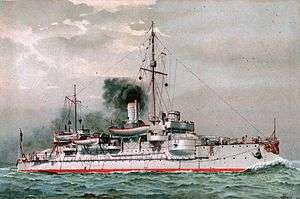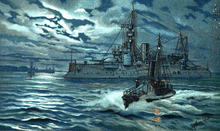SMS Hagen
SMS Hagen was the final vessel of the six-member Siegfried class of coastal defense ships (Küstenpanzerschiffe) built for the German Imperial Navy. Her sister ships were Siegfried, Beowulf, Frithjof, Heimdall, and Hildebrand. Hagen was built by the Kaiserliche Werft Kiel shipyard between 1891 and 1893, and was armed with a main battery of three 24-centimeter (9.4 in) guns. She served in the German fleet throughout the 1890s and was rebuilt in 1900 - 1902. She served in the VI Battle Squadron after the outbreak of World War I in August 1914, but saw no action. Hagen was demobilized in 1915 and used as a barracks ship thereafter. She was ultimately sold for scrap in 1919 and subsequently dismantled.
 Painting of SMS Hagen in 1902 | |
| History | |
|---|---|
| Name: | Hagen |
| Namesake: | Hagen in the Nibelung saga |
| Builder: | Kaiserliche Werft in Kiel |
| Laid down: | September 1891 |
| Launched: | 21 October 1893 |
| Commissioned: | 2 October 1894 |
| Fate: | Scrapped in the Netherlands, 1919 |
| General characteristics as built | |
| Class and type: | Siegfried-class coast defense ship |
| Displacement: | 3,500 metric tons (3,400 long tons) |
| Length: | 79 m (259.2 ft) |
| Beam: | 14.90 m (48.9 ft) |
| Draft: | 5.74 m (18.8 ft) |
| Installed power: | 4,800 ihp (3,600 kW) |
| Propulsion: |
|
| Speed: | 14.8 knots (27.4 km/h; 17.0 mph) |
| Complement: |
|
| Armament: |
|
| Armor: |
|
Design

In the late 1880s, the German Kaiserliche Marine grappled with the problem of what type of capital ship to build in the face of limited naval budgets (owing to parliamentary objections to naval spending and the cost of dredging the Kaiser Wilhelm Canal). General Leo von Caprivi, the new Chef der Admiralität (Chief of the Admiralty), requested a series of design proposals, which ranged in size from small 2,500 long tons (2,500 t) coastal defense ships to heavily-armed 9,800 long tons (10,000 t) ocean-going battleships. Caprivi ordered ten coastal defense ships to guard the entrances to the canal, since even opponents of the navy in the Reichstag (Imperial Diet) agreed that such vessels were necessary. The first six of these, the Siegfried class, were based on the smallest proposal.[1]
Hagen was 79 meters (259 ft) long overall and had a beam of 14.90 m (48.9 ft) and a maximum draft of 5.74 m (18.8 ft). She displaced 3,741 long tons (3,801 t) at full combat load. Her propulsion system consisted of two vertical 3-cylinder triple-expansion engines. Steam for the engines was provided by four coal-fired boilers. The ship's propulsion system provided a top speed of 14.8 knots (27.4 km/h; 17.0 mph) and a range of approximately 1,490 nautical miles (2,760 km; 1,710 mi) at 10 knots (19 km/h; 12 mph). Hagen had a crew of 20 officers and 256 enlisted men.[2]
The ship was armed with three 24 cm K L/35 guns mounted in three single gun turrets. Two were placed side by side forward, and the third was located aft of the main superstructure. They were supplied with a total of 204 rounds of ammunition. The ship was also equipped with eight 8.8 cm SK L/30 guns in single mounts. Hagen also carried four 35 cm (14 in) torpedo tubes, all in swivel mounts on the deck. One was at the bow, another at the stern, and two amidships. The ship was protected by an armored belt that was 240 mm (9.4 in) amidships, and an armored deck that was 30 mm (1.2 in) thick. The conning tower had 80 mm (3.1 in) thick sides.[3] Hagen's armor consisted of new Krupp steel, a more effective type of armor than the compound steel the other members of the class received.[4]
Service history


Hagen was laid down in 1891 at the Kaiserliche Werft shipyard in Kiel. She was launched on 23 October 1893, and completed on 2 October 1894.[5] In July 1895, Hagen, the protected cruiser Kaiserin Augusta, and the old corvettes Marie and Stosch were sent to Morocco in a naval demonstration following the murder of two German nationals in the country. The German government had demanded 250,000 marks as an indemnity, and the naval squadron was sent to secure it.[6] After returning to Germany, Hagen served on active duty with the fleet. In 1897, Hagen participated in the annual summer maneuvers in the IV Division, along with Heimdall and Frithjof. Her other three sisters were assigned to the III Division.[7]
The following year, she was taken into drydock at the Kaiserliche Werft shipyard in Danzig for an extensive reconstruction. The ship was lengthened to 86.13 m (282.6 ft), which increased displacement to 4,247 t (4,180 long tons; 4,682 short tons). Her old boilers were replaced with eight new Thornycroft boilers, and a second funnel was added. Her secondary battery was increased to ten 8.8 cm guns, and the 35 cm torpedo tubes were replaced with three 45 cm (18 in) tubes. Work was completed by 1900.[2] She then returned to service with the fleet, where in 1903 she was in the II Squadron, alongside Beowulf, Heimdall, and Hildebrand.[8]
She remained on active service until the outbreak of World War I in August 1914, when she was mobilized into VI Battle Squadron for coastal defense, along with her sister ships and the two Odin-class coastal defense ships. On 31 August 1915, the VI Battle Squadron was demobilized, and Hagen's crew was transferred to other warships.[9] She was then used as a barracks ship in Libau, Danzig, and Warnemünde. On 17 June 1919, she was stricken from the naval register. She was sold for scrapping to Norddeutsche Tiefbaugesellschaft of Berlin and broken for scrap.[3]
Notes
References
- Dodson, Aidan (2016). The Kaiser's Battlefleet: German Capital Ships 1871–1918. Barnsley: Seaforth Publishing. ISBN 978-1-84832-229-5.
- Gardiner, Robert, ed. (1979). Conway's All the World's Fighting Ships 1860–1905. Greenwich: Conway Maritime Press. ISBN 978-0-8317-0302-8.
- Gardiner, Robert & Gray, Randal, eds. (1985). Conway's All the World's Fighting Ships: 1906–1921. Annapolis: Naval Institute Press. ISBN 0-87021-907-3.
- Gröner, Erich (1990). German Warships: 1815–1945. Vol. I: Major Surface Vessels. Annapolis: Naval Institute Press. ISBN 978-0-87021-790-6.
- "Notes on Naval Progress". General Information Series. Government Printing Office. XVII. 1898.
- Sondhaus, Lawrence (1997). Preparing for Weltpolitik: German Sea Power Before the Tirpitz Era. Annapolis: Naval Institute Press. ISBN 978-1-55750-745-7.
- The United Service. New York: L. R. Hamersly, Jr. V. 1904. Missing or empty
|title=(help)